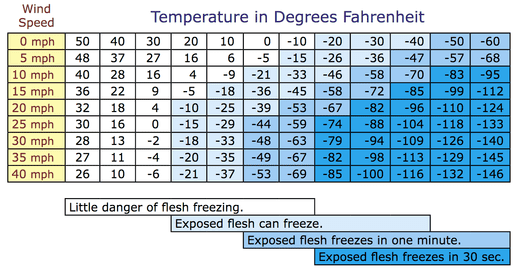|
Okay, winter IS cold. That's why we call it winter. Cold injuries—hypothermia, frostnip, frostbite, chilblains—are all potential problems. Fortunately with a bit of thought and practice, it's possible to stay warm, even in extreme cold. If you are a seasoned winter traveler, you're probably familiar with everything listed here. If you are new to playing outside in the winter, I trust you'll find a few things of value.  Stay Dry. If you are out for multiple days, you need to stay DRY. Yes, dry. This means that you need lots of thin layers; this includes your socks and gloves (think insulated overboots and over mitts). And you need to shed and dawn layers to match your exertion level. Pace your self to avoid significant sweating. Choose your layers carefully so they wick moisture from your body and carry it to the outside. Remember to vent your sleeping bag at night if you find yourself getting too hot. Your extremities cool down first. Never lie your mittens or gloves down, instead tuck them into your parka next to your core where they will stay warm. Release buckles on your hard shell boots whenever possible; compression reduces circulation. Wear loose fitting and flexible mukluks as much as possible to help insure good circulation in your feet. Avoid standing for long periods of time in extreme cold, your hands and feet will cool rapidly without additional insulation or exercise. Avoid removing boots to check for frostbite when traveling in below freezing conditions; do this ONLY after camp has been set-up. Exposing feet to the cold—even if you are putting them on someone's belly to warm up (Brrrrr)—does not work unless they can go from a warm belly into warm booties, mukluks, or a sleeping bag. If you are traveling and you attempt to warm a friend's feet without a camp set up, where do you put them once they are warm? Back into cold boots that have been cooling further the entire time you are warming your friend's feet? This is a guaranteed recipe for frostbite. Eat & Drink enough. Make sure you carry enough calories to meet your energy demands. Use simple carbs to get the internal fire going then load it with protein and fats (logs). When it's extremely cold, consider carry a "food bag" around your neck as you hike (ski, etc.) so you can keep munching when you need it most. Calories in, energy out. Make sure to eat a good dinner with logs and take a carbs/protein/fat food (peanut butter fudge for example) to bed with you to eat if you wake at night. In addition to calories, you'll also need adequate water. Drink it cold if you are hot and hot if you are cold. Get into your sleeping bag HOT! This is perhaps the biggest thing to remember to sleeping warm when it's cold out. If you get in your bag and your are NOT hot, you will likely be cold the entire night. Here's why: Your sleeping bag is cold when you get in it; you've got to warm it up and trap heat to sleep warm. If you get in cool, you'll be cold once the sleeping bag "sucks" what little heat you have away. So...go for a hike, ski, etc. until you start to feel too HOT (don't pass the sweat point), then get in your bag. You'll warm the bag up as you cool down (the cool bag should feel good at this point) and you trap enough excess heat to keep you warm. Store your nightly food stash near your head so you can find it when you need it. Finally, wear a hat and if you have cold feet, fill a nalgene bottle with hot water, cover it with a couple of socks, and keep it by your feet. Toasty. Remember to use a piece of plastic bag to act as a washer to get a perfect seal; you definitely don't want the bottle to leak.... There is a myth out there that you should always sleep in your underwear (or naked) in a sleeping bag. This one's REALLY silly. If you are cool or cold, you need more insulation not less. Bring a few extra layers into your bag with you. If you wake up a little cool, eat something, and put them on. Putting the already warm layers on inside your bag will generate a bit of heat and help you to fall asleep easier. Put good insulation UNDER your bag. Here's where self-inflating sleeping pads with reflective mylar really shine. The thicker, the better. Watch out for wind CHILL. When it's below freezing, protect yourself from the wind.This includes: wind shells, hood with tunnels and fur (both help trap a warm bubble of air near your face), insulated face masks, and goggles. Monoter exposed skin at all times: Watch for frostbite.
0 Comments
Your comment will be posted after it is approved.
Leave a Reply. |
Categories
All
Our public YouTube channel has educational and reference videos for many of the skills taught during our courses. Check it out!
|


 RSS Feed
RSS Feed
